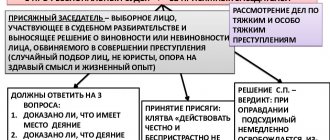Category: Criminal trial.
The law distinguishes between two types of verdicts: guilty and acquittal. The defendant is either found guilty of the crime or acquitted. This means that all questions of the prosecution must be answered categorically in the verdict. The court renders only one verdict in a case, even when one person is charged with multiple charges or when the issue of several accused is being decided in one case. Therefore, the verdict, being a single document, can be acquittal in relation to some accused and the charges brought against them, and acquittal in relation to others.
A guilty verdict is given if the defendant's guilt is proven during the trial. A conviction cannot be based on assumptions (Part 4 of Article 302 of the Code of Criminal Procedure of the Russian Federation). The court pronounces a guilty verdict if he answers unequivocally in the affirmative to all the first four questions of Art. 299 Code of Criminal Procedure of the Russian Federation. A conviction must be based only on evidence examined in court and recognized by the court as reliable.
The exception is the provisions specified in section 10 of the Code of Criminal Procedure of the Russian Federation, which provide for a special procedure for judicial proceedings, the purpose of which is to simplify proceedings in cases of minor and medium gravity in the interests of ensuring the fastest and most effective administration of justice.
The court does not have the right to pronounce a guilty verdict unless all conclusions in defense of the defendant have been verified and refuted and all doubts about his guilt have been eliminated. The previous criminal procedure law established the following rules: if doubts about the proof of the charge could not be eliminated by further examination of the evidence in court or by sending the case for a preliminary investigation, without violating the principle of adversarial law, the court had to pronounce an acquittal. In this case, the court had to be guided by the provision arising from the principle of the presumption of innocence that all doubts should be interpreted in favor of the defendant.
The requirements of the Code of Criminal Procedure of the Russian Federation have become more stringent. In connection with the abolition of the institution of pre-investigation, the court, in all cases provided for by law, must render an acquittal.
Convictions, depending on how they resolve the issue of punishment (Part 5 of Article 302 of the Code of Criminal Procedure of the Russian Federation), can be of three types:
- with the imposition of punishment;
- with the imposition of a sentence and release from serving it;
- without imposing punishment.
A guilty verdict with the imposition of punishment is issued in cases where the court believes that the defendant is subject to punishment for the crime committed and there are no obstacles to its imposition (the statute of limitations has not expired, there are no acts of amnesty). If the sentence imposed by the court is to be served by the convicted person, the court is obliged to determine the type, amount and beginning of the calculation of the sentence.
A guilty verdict is issued with an exemption from serving the sentence (if it is assigned), for example, due to the fact that the convicted person actually served it in connection with the choice of a preventive measure in the form of detention.
It seems that in a verdict of guilty with release from punishment, the court does not always have to initially assign a punishment to the convicted person. He may decide on release from serving the sentence without determining this specific measure. When a guilty verdict is passed with an exemption from punishment, it is necessary to impose a certain penalty only in the case where the application of the amnesty act depends on it.
A guilty verdict without imposing punishment is issued in cases where the court comes to the conclusion that, due to a change in the situation, the act committed by the perpetrator has lost the character of a socially dangerous act or the person has ceased to be socially dangerous. If these grounds exist, the proceedings are often terminated at an earlier stage. But if these circumstances are discovered during the trial or the accused at earlier stages objected to the termination of the case on these grounds, and at the court hearing the accusation was confirmed, the court is obliged to pronounce a guilty verdict and release the defendant from punishment.
An important issue is exemption from criminal liability due to the expiration of the statute of limitations. Art. 78 of the Criminal Code of the Russian Federation states that due to the expiration of the statute of limitations, a person is released from criminal liability, and not from punishment.
Exemption from criminal liability means a decision expressed in an act of a competent state body to release a person who has committed a criminal offense from the obligation to be subject to judicial conviction and undergo measures of state coercive influence and is more favorable for the person brought to criminal liability than the release of this person from punishment .
At the same time, the decision on the issue of exemption from criminal liability due to the expiration of the statute of limitations can be made both at the stage of assigning the case to a hearing in court, and during the trial, if these grounds arose precisely at this time.
A person’s disagreement with his release from criminal liability due to the expiration of the statute of limitations obligated the court to bring the trial to an end and pronounce an acquittal or conviction, but the latter, without imposing punishment, would release the person from punishment.
A person’s disagreement with release from criminal liability due to the expiration of the statute of limitations means that the defendant does not consider himself guilty. Therefore, the question of his guilt must be resolved by a court verdict. However, after the defendant is found guilty by a court verdict, he can no longer be freed from judicial conviction as an integral element of criminal liability. In such a situation, the convicted person can only be released from punishment.
This is exactly how this issue is resolved in the Code of Criminal Procedure of the Russian Federation, where in Art. 24 states that a criminal case cannot be instituted, and the instituted case is subject to termination due to the expiration of the statute of limitations for criminal prosecution.
Termination of the case on this basis is not allowed if the accused objects to this. In this case, the proceedings in the case continue and are completed, if there are grounds for this, by a guilty verdict with the release of the convicted person from punishment.
In cases where the defendant does not deny the crime, the court must, by ruling (ruling), release the person from criminal liability due to the expiration of the statute of limitations and terminate the criminal case in connection with this.
The Code of Criminal Procedure of the Russian Federation does not contain a detailed description of the actions of the court in the event of release from criminal liability in connection with active repentance, in connection with reconciliation with the victim. But Art. 254 of the Code of Criminal Procedure of the Russian Federation instructs the court to terminate criminal cases at a court hearing in these cases as well.
It should be borne in mind that a ruling (decision) to terminate such a case can be made by the court at any time during the court hearing, as soon as sufficient grounds for this have been identified.
Concept and properties of a sentence
A court verdict is a decision on the innocence or guilt of the defendant and the imposition of punishment on him or on his release from punishment, made by the court of first instance or appeal (clause 28 of Article 5 of the Criminal Procedure Code). The verdict ends the work of the trial court. This is the only procedural document that is issued in the name of the Russian Federation.
The requirements of legality, validity and fairness are imposed on the verdict. In accordance with Art. 297 of the Criminal Procedure Code, a sentence is considered legal, reasonable and fair if it is pronounced in compliance with the procedure established by the Code of Criminal Procedure and is based on the correct application of the criminal law.
The validity of the verdict assumes that all the court's conclusions set out in it are based on evidence examined during the trial and correspond to the factual circumstances of the case.
A fair sentence should be considered one in which the question of the guilt or innocence of the defendant is correctly resolved and the punishment is determined taking into account the gravity of the crime and the personality of the defendant.
Assessment of the significance of violations of the Code of Criminal Procedure
In Part 2 of Art. 381 defines the circumstances under which acquittals may be reviewed. In Russia, however, violations not always specified in the norm may lead to the unconditional appointment of a rehearing.
So, for example, if during the proceedings there was a violation of the defendant’s right to the assistance of an interpreter or lawyer, or he was not allowed to participate in the debate, or the last word was not given, the reversal of the sentence will be meaningless. This is due to the fact that formally these circumstances did not worsen the subject’s position or influence the making of an unreasonable, illegal or unfair decision.
Overturning the verdict would turn the hearing into a farce in this case, since the outcome would be predetermined. Review of the decision in this case is possible only if there is a complaint from the subject who has been found innocent and if he does not agree with the conditions for making this decision.
Types of sentences
The court verdict may be acquittal or guilty.
The acquittal
it is decided:
- if the crime has not been established;
- the defendant is not involved in the commission of a crime;
- there is no corpus delicti in the defendant’s act;
- the jury returned a not guilty verdict against the defendant.
Acquittal on any of the above grounds means the defendant is declared innocent and entails his rehabilitation.
Conviction
cannot be based on assumptions and is decided only on the condition that during the trial the defendant’s guilt in committing a crime is confirmed by a sufficient body of reliable evidence examined by the court.
A conviction may be:
- with the imposition of a criminal sentence to be served by the convicted person;
- with the imposition of a criminal punishment and release from serving it, if the statute of limitations for criminal prosecution has expired, or an act of amnesty has been issued, exempting from the application of the punishment imposed on the convicted person by this sentence, or the time the defendant has been in custody, taking into account the rules for counting pre-trial detention, absorbs the punishment assigned to him court;
- without imposing criminal penalties.
Classification
In Art. 309 of the Code of Criminal Procedure provides for two types of final decisions on the act in question: conviction and acquittal. All questions in the decision must have a categorical answer.
The subject acting as a defendant is either found guilty or acquitted. The authorized person makes only one decision. This rule also applies to cases where several charges are brought against one person at the same time or the crimes of several persons are considered as part of the proceedings.
Also read: What happens for phone theft, what article regulates the punishment
In this regard, the verdict as a single document can be acquittal for some citizens and acquittal for others. In one act, punishment may be imposed on some, and the release of others may be decreed.
Sentencing procedure
The verdict is decided by the court in the deliberation room. During the sentencing, only judges who are members of the court in this criminal case may be in this room. Judges do not have the right to disclose judgments that took place during the discussion and rendering of the verdict.
The court discusses in the deliberation room the issues to be resolved in the verdict, in the order in which they are given in Art. 299 of the Criminal Procedure Code:
- whether it has been proven that the act of which the defendant is accused took place;
- whether it has been proven that the defendant committed the act;
- whether this act is a crime, and what clause, part, or article of the Criminal Code provides for it;
- whether the defendant is guilty of committing this crime;
- whether the defendant is subject to punishment for the crime he committed;
- whether there are circumstances mitigating or aggravating his punishment;
- what punishment should be imposed on the defendant;
- are there any grounds for passing a sentence without imposing punishment or exemption from punishment;
- what type of correctional institution and regime should be determined for the defendant when assigning him a sentence of imprisonment;
- whether the civil claim can be satisfied, in whose favor and in what amount;
- what to do with property that has been seized to secure a civil claim or possible confiscation;
- how to deal with material evidence;
- to whom and in what amount should procedural costs be imposed;
- whether the court, in cases established by law, should deprive the defendant of a special, military or honorary title, class rank, as well as state awards;
- whether compulsory educational measures can be applied to a minor defendant;
- whether compulsory medical measures can be applied to defendants suffering from chronic alcoholism, drug addiction or mental illness that does not preclude sanity;
- Should the preventive measure against the defendant be canceled or changed?
If the defendant is accused of committing several crimes, then the court resolves the issues specified in paragraphs 1–7 for each crime separately.
If several defendants are accused of committing a crime, the court resolves these issues in relation to each defendant separately, determining the role and degree of his participation in the committed act.
If the case was considered by a collegial panel of the court, the presiding judge raises the above issues for resolution. When resolving each issue, the judge does not have the right to abstain from voting. All issues are resolved by majority vote. The presiding officer is the last to cast his vote.
A judge who voted to acquit the defendant and remained in the minority is given the right to abstain from voting on issues of application of criminal law. If the opinions of the judges on the issues of qualification of the crime or the measure of punishment differ, then the vote cast for acquittal is added to the vote cast for the qualification of the act under the criminal law, providing for a less serious crime, and for the imposition of a less severe punishment.
An exceptional measure of punishment - the death penalty can be imposed on a guilty person only by unanimous decision of all judges.
The judge who has a dissenting opinion on the verdict has the right to express it in writing in the deliberation room. The dissenting opinion is attached to the verdict and is not subject to announcement in the courtroom (Article 301 of the Criminal Procedure Code).
Penalties
The imposed fine without installment payment must be paid before the expiration of 60 days from the date of entry into force of the judicial act.
When the convicted person cannot immediately pay the fine, the court, at his request, applies an installment plan in the form of a fine for up to five years.
A convicted person to whom sanctions have been applied in the form of a fine with installment payment, as well as in respect of whom the court has adopted an act on installment payment of the fine, are required to pay the specified part of the fine within 60 days from the date the act came into force. The remaining installments must be paid each month no later than the end day of each subsequent month.
Contents and form of the sentence
The verdict is stated in the language in which the trial took place, and consists of introductory, descriptive and motivating parts and operative parts.
The verdict must be handwritten or produced using technical means by one of the judges participating in its decision. The verdict is signed by all judges, including the judge with a dissenting opinion.
Corrections in the verdict must be agreed upon and certified by the signatures of all judges in the deliberation room before the verdict is announced (Article 303 of the Criminal Procedure Code).
In the introductory part of the sentence
indicated:
- on rendering a sentence in the name of the Russian Federation;
- time and place of sentencing;
- the name of the court that rendered the verdict, the composition of the court, information about the secretary of the court session, the prosecutor, the defense attorney, the victim, the civil plaintiff, the civil defendant and their representatives;
- the name, patronymic and surname of the defendant, the date and place of his birth, place of residence, place of work, occupation, education, marital status and other information about the personality of the defendant relevant to the case;
- clause, part, article of the Criminal Code, providing for liability for the crime of which the defendant is accused (Article 304 of the Criminal Procedure Code).
In the descriptive and motivational part of the acquittal
states:
- the essence of the accusation;
- circumstances of the case established by the court;
- the grounds for acquitting the defendant and the evidence supporting them;
- the reasons why the court rejects the evidence presented by the prosecution;
- reasons for the decision regarding the civil claim.
It is not allowed to include in the acquittal sentence language that casts doubt on the innocence of the acquitted person (Article 305 of the Criminal Procedure Code).
In the operative part of the acquittal
are indicated:
- surname, name and patronymic of the defendant;
- the decision to find the defendant innocent and the grounds for his acquittal;
- decision to cancel a preventive measure, if it was chosen;
- a decision to cancel measures to ensure confiscation of property, as well as measures to ensure compensation for harm, if such measures were taken;
- clarification of the procedure for compensation for damage associated with criminal prosecution (Article 306 of the Criminal Procedure Code).
Descriptive and motivational part of the guilty verdict
must contain:
- description of a criminal act recognized by the court as proven, indicating the place, time, method of its commission, form of guilt, motives, goals and consequences of the crime;
- the evidence on which the court's conclusions regarding the defendant are based, and the reasons for which the court rejected other evidence;
- an indication of the circumstances mitigating and aggravating the punishment, and if the charge is found to be unfounded in any part or the crime is incorrectly classified - the grounds and motives for changing the charge;
- motives for resolving all issues related to the imposition of a criminal punishment, release from it or from its actual serving, and the use of other measures of influence;
- evidence on which the court's conclusions are based that the property subject to confiscation was obtained as a result of the commission of a crime or is the proceeds of this property or was used or intended to be used as an instrument of crime or for the financing of terrorism, an organized group, an illegal armed group, a criminal community (criminal organization);
- justification for decisions made on other issues resolved by the court (Article 307 of the Criminal Procedure Code).
The operative part of the guilty verdict
must contain:
- surname, name and patronymic of the defendant;
- a decision to find the defendant guilty of a crime;
- an indication of the paragraph, part, article of the Criminal Code, providing for liability for the crime of which the defendant was found guilty;
- the type and amount of punishment imposed on the defendant for each crime of which he was found guilty;
- the final penalty to be served;
- the type and regime of the correctional institution in which a person sentenced to imprisonment must serve his sentence;
- the duration of the probationary period during a suspended sentence and the responsibilities that are assigned to the convicted person;
- decision on additional types of punishment;
- a decision to count the time of preliminary detention if the defendant was detained before the verdict was pronounced or preventive measures were applied to him in the form of detention, house arrest, or he was placed in a medical or psychiatric hospital;
- decision on a preventive measure against the defendant before the sentence enters into legal force.
If the defendant is charged under several articles of the criminal law, then the operative part of the sentence must clearly indicate which of them the defendant was acquitted of and which of them he was convicted of (Article 308 of the Criminal Procedure Code).
In addition, the operative part of the sentence must contain:
- decision on a civil claim;
- resolving the issue of material evidence;
- decision on the distribution of procedural costs;
- instructions on the procedure and deadlines for appealing a verdict, on the right of the convicted and acquitted to petition for participation in the consideration of the case by the court of cassation (Article 309 of the Criminal Procedure Code).
Meaning
The verdict is considered the only procedural act decided on behalf of the state. This is enshrined at the legislative level in Art. 296 Code of Criminal Procedure. The verdict evaluates the previously brought charges. The resolution acts as a substantive and legal means. The act itself is only an element of the charge.
At the same time, there are other, no less important components. They form the key evidentiary fact. These elements include the subject, the subjective side and the object. The prosecutor approves the indictment so that it becomes the subject of proceedings in full and not in part. When making a decision, the authorized person examines the thesis of the conclusion. All charges are resolved on their merits after a detailed examination of the circumstances.
The verdict is an act of the criminal process, the core of decisions that are made before and after it. This decision not only ends the stage of proceedings in the first instance. The verdict finally resolves the main issues of legal proceedings. It acts as the final result of the work of law enforcement agencies in terms of legal and factual consequences.
Proclamation of the verdict
After signing the verdict, the court returns to the courtroom and the presiding judge announces the verdict. Everyone present in the courtroom, including the court panel, listens to the verdict while standing.
If the sentence is stated in a language that the defendant does not speak, then after the announcement of the sentence or simultaneously it is translated aloud by an interpreter into a language that the defendant speaks.
If the defendant is sentenced to an exceptional punishment - the death penalty, the presiding judge explains to him the right to apply for pardon.
If only the operative part of the verdict is announced, the court explains to the participants in the trial the procedure for familiarizing themselves with its full text.
No later than five days after the pronouncement of the verdict, a copy of it is handed over to the convicted or acquitted person, his defense attorney and the prosecutor. Within the same period, a copy of the verdict may be served on the victim, civil plaintiff, civil defendant and their representatives upon the request of these persons.
A special case
In Russia, acquittals can be made at a hearing with the participation of a jury.
In this case, a special procedure for reviewing such decisions is provided. The verdict may be canceled upon the proposal of the prosecutor or a complaint from the victim (representative of the defense) in the presence of such violations of the Code of Criminal Procedure that limited the participants in the proceedings from presenting evidence or they influenced the essence of the questions posed to the jury and, accordingly, the answers to them.
The cassation authority cannot go beyond these conditions and review decisions based on other circumstances.








